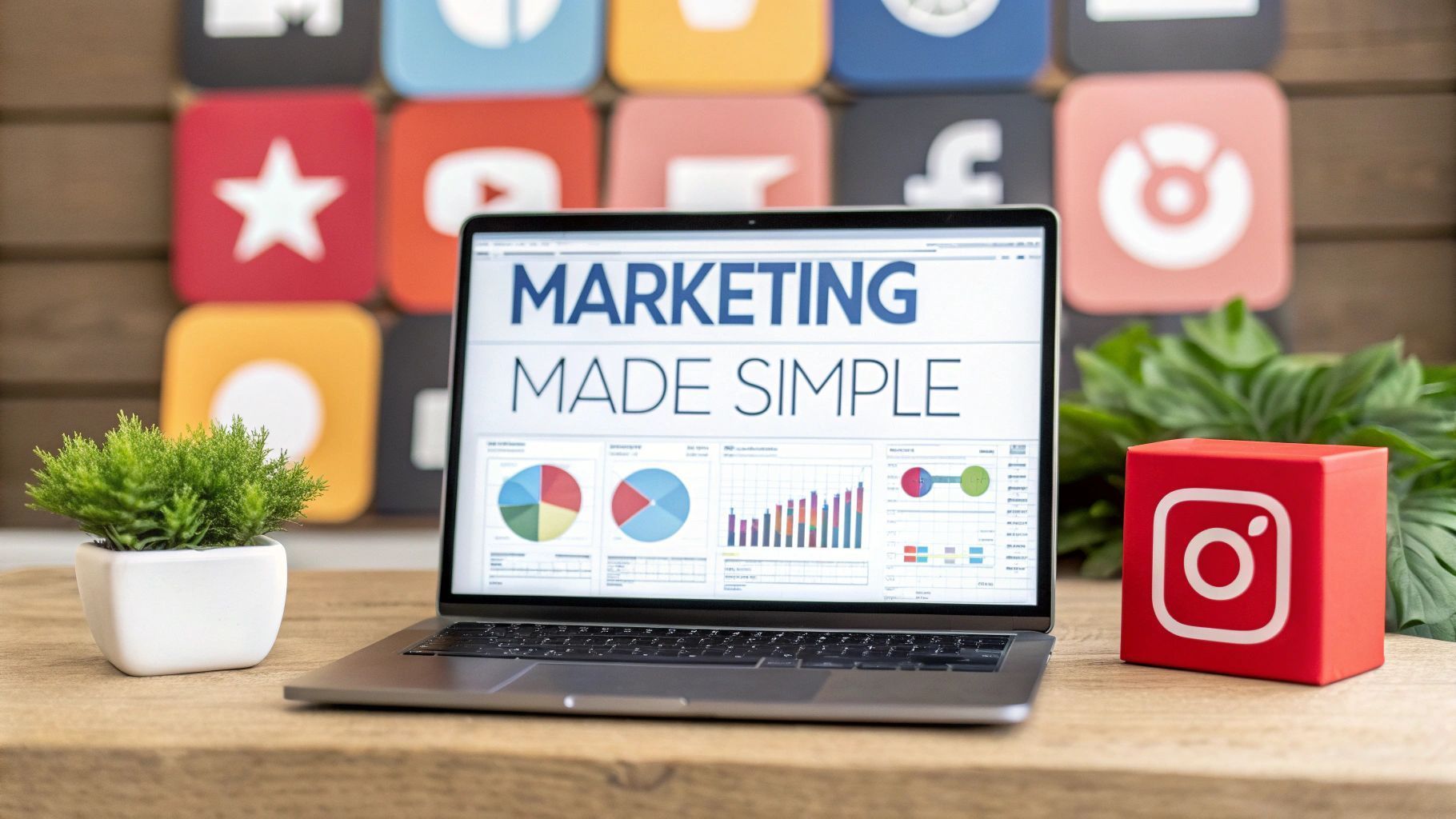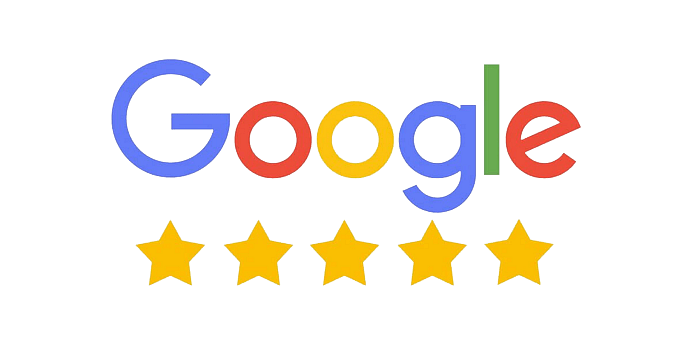Content Marketing for Small Business: Boost Your Growth
Content marketing isn't some complex, jargon-heavy mystery reserved for big corporations. For a small business it's simply the art of creating genuinely useful online material—think blog posts, videos and guides—to attract and connect with your ideal customers. Instead of a direct sales pitch, you're offering help and expertise. This approach builds trust and naturally draws people to your brand over the long haul, driving growth without the hard sell.
Why Content Marketing Is Your Secret Weapon
Let's cut right to it. Content marketing isn't about shouting the loudest with flashy ads. It’s about becoming the most helpful, reliable voice in your field. Think of yourself as the trusted local expert everyone turns to for advice, not the pushy salesperson they try to avoid. That’s the core of it.
Instead of interrupting potential customers with ads they didn’t ask for, you pull them in by offering real solutions to their problems. You do this by consistently creating and sharing content that directly answers their questions and speaks to their needs.
Building Trust Beyond Advertising
Traditional advertising tells people you’re great. Good content marketing shows them. By providing genuine value without immediately asking for a sale, you build a foundation of trust that paid ads simply can't buy.
Imagine a potential customer finding your helpful blog post through a Google search or stumbling upon your insightful video on social media. That single interaction creates a positive, memorable connection. It shifts your business from being just a seller of things to a go-to resource people rely on.
This is absolutely crucial for building lasting relationships. People are far more likely to buy from a brand they see as a trusted authority. In fact, the role of content marketing in building brand authority is one of the most powerful drivers for sustainable growth.
An Investment That Grows Over Time
Here’s the best part. Unlike a paid ad that vanishes the moment your budget runs out, your content is a long-term asset. A single, well-crafted blog post or video can keep attracting traffic, generating leads and building your reputation for months—sometimes even years—after you publish it.
Think of it as planting a tree rather than buying a bouquet of flowers. One provides value that grows and compounds over time, while the other offers a fleeting moment of visibility.
This makes content marketing an incredibly efficient strategy, especially for businesses with tight budgets. Every piece you create adds to a growing library of resources that works for you around the clock, establishing a strong online presence that steadily attracts the right kind of customers.
For a deeper look into strategy and planning, this ultimate guide to content marketing for small business is a fantastic starting point.
Building Your Strategy on a Small Business Budget
Let's clear up a common myth: powerful content marketing isn't about having the deepest pockets. Far from it. A massive budget means nothing without a smart plan. As a small business, your greatest advantage isn’t outspending the competition—it’s out-thinking them.
The key is learning how to develop a content strategy that gets results , especially when every pound counts. This isn't about creating content for the sake of it. It’s about making sure every single piece you publish has a clear job to do, moving you one step closer to your goals.
This smart, focused approach is becoming the norm across the UK. Today, 73% of B2B marketers and 70% of B2C marketers have woven content marketing into their core strategies. It's a clear signal of its value, with around 39% of companies now setting aside between £1,000 and £5,000 each month for their content efforts.
Know Your Ideal Customer Intimately
Before you even think about writing a single word, you need a crystal-clear picture of who you're talking to. Firing off generic content is the quickest way to waste your time and money. The goal is to build a detailed profile of your perfect customer.
Go deeper than just age and location. What are their real-world problems? What keeps them up at night? What exact phrases are they typing into Google when they’re looking for help? When you understand their pain points, you can create content that offers real solutions and instantly positions you as the expert they've been searching for.
Think about it: a local personal trainer writing about "general fitness tips" will get lost in the noise. But if they create content specifically addressing "workout routines for busy parents with no time", they immediately become hyper-relevant to their ideal audience. That's the difference.
Set Crystal Clear Business Goals
Your content needs a destination. Without one, you're just wandering aimlessly. Vague wishes like "get more leads" aren't goals; they're just hopes. You need specific, measurable targets to aim for.
A goal is not just a result; it is a clear instruction for your marketing. A target like "increase website enquiries from our blog by 20% in the next quarter" gives your content a specific job to do.
This clarity is everything. It transforms your content from a passive "nice-to-have" into an active, business-building machine. Every blog post, video or social update becomes a deliberate move designed to hit those targets.
Identify Your Key Content Channels
Spreading yourself too thin is a classic small business mistake. You can't be everywhere at once and you shouldn't try. The trick is to be strategic and show up where it actually matters.
Where do your ideal customers spend their time online? Your customer research should give you the answer. Don't just guess—find out if they're scrolling through LinkedIn, getting inspired on Pinterest or chatting in local Facebook groups.
- B2B Services: If you're an accountant or a consultant, your audience is almost certainly on LinkedIn.
- Visual Products: Running a craft business or a bakery? Your best bet is a visual platform like Instagram or Pinterest.
- Local Services: For a tradesperson or a local shop, engaging in community-focused Facebook groups can deliver incredible results.
By focusing your energy on just one or two key channels, you can create genuinely high-quality content that resonates, instead of posting mediocre content everywhere. It’s a simple formula: quality and focus will always beat quantity.
Choosing Content That Genuinely Connects
Once your strategy is mapped out, it’s time for the fun part: deciding what your content will actually look and feel like.
Not all content formats are created equal. What works for a massive corporation probably won’t be the right fit for your small business. The real key is to choose formats that genuinely connect with your audience and feel authentic to your brand’s voice.
It’s all about matching the message to the medium. An in-depth guide is perfect for explaining a tricky topic, whereas a quick, punchy video can stop someone in their tracks on a busy social media feed. Let's walk through the formats that best suit your skills, resources and—most importantly—your customers' needs.
The Power of Detailed Blog Posts
For most small businesses, a well-written blog is the absolute cornerstone of their content marketing. Think of your blog as the digital home for your expertise. Blog posts are powerhouse assets for boosting your search engine rankings and establishing you as an authority on the topics your customers actually care about.
Imagine a potential customer searching for a solution to a problem and they land on your detailed, helpful article. That builds instant trust. It proves you understand their challenges and have the know-how to help. This is where you can really shine, whether you’re a local bakery sharing a secret family recipe or a financial adviser breaking down the complexities of pension plans.
A great blog post doesn't just attract visitors; it educates them. It answers their questions so thoroughly that they see you not just as a business but as a trusted resource worth returning to.
Better yet, blogs are incredibly versatile. A single, well-researched post can easily be repurposed into a dozen social media updates, a series of email newsletters or even a script for a video. That makes it one of the most efficient investments you can make.
Engaging Videos for the Modern Audience
Video isn’t a "nice-to-have" any more; it’s an essential tool for grabbing and holding attention. UK small businesses are weaving video into their core strategies because it meets a massive consumer demand. In fact, a staggering 83% of UK consumers want to see more video content from brands in 2025.
Videos have an almost magical ability to stop the scroll on platforms like Instagram and Facebook in a way that text often can’t. They let you show off your personality, demonstrate a product in action or share a behind-the-scenes peek at your business. That human element is fantastic for building a real, personal connection with your audience.
Here are a few simple video ideas any small business can try:
- How-To Guides: Show customers how to get the most out of your product or solve a common problem.
- Meet the Team: Introduce the people behind the business. It’s a brilliant way to build trust and feel more relatable.
- Customer Testimonials: Let your happy clients do the talking! Their positive experiences, shared on camera, are incredibly persuasive.
This graphic offers a great starting point for content frequency. It shows how a balanced approach—combining less frequent but deeper content like blogs with more regular social posts—can be incredibly effective.
Content Format Comparison for Small Businesses
Choosing the right format can feel overwhelming, so this table breaks down some of the most popular options to help you decide where to focus your energy.
| Content Type | Primary Goal | Best Platform(s) | Key Benefit |
|---|---|---|---|
| Blog Posts | Build authority, drive SEO traffic | Your website, LinkedIn | Long-term asset that builds organic trust |
| Short-Form Video | Grab attention, showcase personality | TikTok, Instagram Reels, YouTube Shorts | High engagement and brand visibility |
| Case Studies | Provide social proof, build credibility | Website, sales proposals, LinkedIn | Converts late-stage leads into customers |
| Email Newsletters | Nurture leads, drive repeat business | Email marketing platforms | Direct, personal communication with audience |
| Infographics | Simplify complex data, encourage shares | Pinterest, blog posts, social media | Highly shareable and easy to digest |
Each format has its own superpower. The trick is to create a healthy mix that keeps your audience engaged at every stage of their journey with you.
Building Unshakeable Trust with Case Studies
When a potential client is on the verge of making a decision, they're looking for one thing: proof. They want to know you can deliver on your promises. This is where case studies and honest success stories become your most powerful sales tool. They are real-world examples of how you solved a problem for a client just like them.
A good case study is much more than a simple testimonial; it's a compelling story. It should clearly outline the client's initial challenge, walk through the solution you provided and—most importantly—showcase the tangible, measurable results you achieved. This storytelling approach makes your services feel far more relatable and credible.
Telling these authentic stories is a vital skill. Learning how brand storytelling builds loyalty and revenue can completely transform how you present your successes. It turns simple case studies into powerful trust-building assets that persuade and convert, providing the social proof many buyers need before they’ll commit.
Getting Your Content Seen by the Right People
Creating brilliant content is a huge achievement but it’s only half the job. The most insightful blog post or engaging video is useless if your ideal customers never actually see it. This is where strategic distribution comes in, turning your hard work into real business results.
Think of your content as a beautifully crafted message in a bottle. Just tossing it into the vast ocean of the internet and hoping for the best is a recipe for disappointment. Instead, you need a plan to deliver that message directly to the people who are waiting to hear it.
Harnessing Social Media Strategically
Social media is more than just a place for updates; it's a powerful network for getting your content in front of the right eyes. The key is to be selective. Don’t just spray and pray across every platform out there. Focus your energy where your audience is already active.
For many UK B2B marketers, LinkedIn is the undeniable champion. A remarkable 89% use it for lead generation and 62% say it works. On the flip side, businesses talking to consumers often get more traction on visual platforms. For UK companies, Instagram's average engagement rate of 0.43% easily beats Facebook ( 0.063% ) and X ( 0.029% ), making it a prime spot for interaction.
To get this right, you need to:
- Pick Your Playground: If you’re a B2B consultant, LinkedIn is your stage. Selling handcrafted homeware? Pinterest and Instagram are your galleries.
- Adapt, Don’t Just Post: Never just copy and paste. Turn a key point from your blog into a thought-provoking LinkedIn question. Create a short, snappy video for Instagram Reels.
- Be Part of the Conversation: Jump into discussions, reply to comments and be a valuable member of the community. Distribution is a two-way street.
Building Your Most Valuable Asset: An Email List
An email list is one of the most powerful tools you can have. Unlike social media algorithms, which can change overnight without warning, your email list is something you completely own and control. It’s a direct line to your most engaged followers.
Building an email list is like gathering a dedicated audience in your own private theatre. You get to speak to them directly, without the noise and distraction of the public square.
Start by offering something valuable in exchange for an email address – a helpful checklist, an exclusive guide or a discount code. Once people subscribe, nurture that relationship by consistently sharing your best content straight to their inbox. This builds loyalty and keeps you top of mind.
Driving Long-Term Growth with SEO Basics
Search Engine Optimisation (SEO) is all about making your content more visible when people search on Google. It’s your ticket to a steady stream of free, high-quality traffic from people actively looking for the solutions you offer. Think of it as the ultimate long-term play in content distribution.
For small businesses, SEO isn't about baffling technical tricks. It’s about understanding what your customers are searching for and creating content that gives them the answers they need.
Here’s where to start:
- Find Your Keywords: Think about the phrases your ideal customer would type into Google. Tools like Google Keyword Planner can help you find popular search terms related to your business.
- Optimise Your Content: Weave these keywords naturally into your page titles, headings and throughout your text. Don't force it; make it read well.
- Create Genuinely Helpful Content: At the end of the day, Google just wants to show its users the most useful, relevant results. Focus on creating high-quality, in-depth content that truly helps the reader.
By optimising your content, you're not just publishing it; you are making it discoverable for months and even years to come. For a deeper dive, check out our guide on unlocking the power of SEO and watch your online presence grow.
Measuring What Truly Matters for Your Business
Creating fantastic content is a huge achievement but how do you actually know if it’s working? To get a real sense of your impact, you need to look past the surface-level numbers and focus on the data that’s genuinely driving your business forward.
This means moving beyond ‘vanity metrics’ like social media likes or follower counts. While they’re nice to see, they don’t always translate into new customers or more revenue. The real goal is to measure the actions that show genuine interest and get you closer to your business objectives.
Let's walk through the key performance indicators (KPIs) that matter most for a small business. We'll look at how free tools can help you track meaningful results, from website traffic to lead generation, so you can confidently refine your content marketing for small business and get the best possible return.
Moving Beyond Vanity Metrics
It’s easy to get distracted by numbers that look impressive but offer little real value. A blog post with a thousand shares is great but if it doesn’t lead to a single enquiry or sale, was it truly a success? The key is to shift your focus to metrics that show real audience engagement and an intent to buy.
Instead of just counting likes, start asking deeper questions:
- How many people who read our blog post signed up for our newsletter?
- Did our latest case study lead to more contact form submissions?
- Which social media posts are driving the most clicks back to our website?
These are the metrics that tell a story about your content's effectiveness. They connect your creative work directly to tangible business outcomes, helping you understand what resonates with your audience and what prompts them to take the next step.
Key Performance Indicators That Drive Growth
To measure your content properly, you need to track the right KPIs. These are the indicators directly linked to your business goals, giving you a clear picture of what is and isn't working.
Here are the core metrics every small business should be monitoring:
-
Website Traffic: This is your foundation. Using a free tool like Google Analytics , you can see how many people are visiting your site, which pages they’re looking at and where they’re coming from. A surge in traffic to a specific blog post is a strong sign that the topic is a hit with your audience.
-
Time on Page: This metric reveals how long visitors are actually spending with your content. A longer time on page suggests your writing is engaging and valuable, holding the reader's attention. If people are bouncing off quickly, it might be a sign that your content isn't matching their expectations.
-
Conversion Rate: This is one of the most important metrics of all. A conversion is any desired action a visitor takes, like filling out a contact form, downloading a guide or signing up for your email list. Tracking your conversion rate tells you how effective your content is at persuading people to act.
Measuring content isn't just about counting clicks; it's about understanding behaviour. The goal is to see how your content guides a potential customer from being a casual visitor to becoming a genuine lead.
By focusing on these practical KPIs, you can start making informed decisions. You can double down on the types of content that generate leads and refine or replace those that don't, ensuring your time and resources are always well spent.
Future-Proofing Your Content Strategy
The online world is always shifting but the heart of great content marketing stays the same. To stay ahead, you don't need to jump on every passing trend. The real skill is adapting timeless principles to the tools and expectations of today's audience.
Let's be honest: the bar for quality is getting higher. As more businesses start creating content, just showing up isn’t enough any more. The future belongs to those willing to go deeper—to provide material that’s more insightful, comprehensive and genuinely helpful than anyone else.
This marks a strategic shift away from quantity and towards real quality. Small businesses across the UK are already putting their money where their mouth is, with a clear trend toward investing more into each piece of content. In 2023, 44.4% of businesses spent under £500 per piece; that figure is expected to plummet to just 20.9% in 2024.
Instead, a clear majority ( 53.1% ) are now planning to invest between £550 and £2,000. It’s a confirmation that deeper, more valuable content is now the priority. You can dig into more of these marketing spending trends over at Reboot Online.
Embracing AI as a Smart Assistant
Artificial intelligence is often painted as a replacement for human creativity but that’s not the right way to look at it. Its true strength lies in its ability to be an incredibly capable assistant. It can supercharge your research, help you analyse data and even sketch out outlines for new topics. This frees you up to focus on the truly human parts: storytelling, expertise and connection.
Think of AI as the tool that handles the groundwork, not the one that builds the final product.
- Research: Use it to quickly pull together information or pinpoint common questions your customers are asking.
- Optimisation: AI can help you find relevant keywords or suggest ways to make your headlines punchier.
- Ideation: When you're stuck for ideas, AI can offer a solid starting point to get the brainstorming started.
This kind of partnership allows you to produce more thoughtful, well-researched content far more efficiently. It’s not about letting a machine write for you; it's about using technology to elevate your own unique voice and insight.
The Timeless Power of Providing Genuine Value
In the end, every trend, tool and tactic has to serve one core principle that will never go out of style: providing genuine value. This is the bedrock of any content strategy built to last.
Technology and platforms will change but the human desire for helpful, authentic and trustworthy information will not. Your most future-proof strategy is to become an indispensable resource for your audience.
When you consistently solve problems, answer questions and share what you know without asking for anything in return, you build something far more powerful than clicks or traffic. You build lasting relationships. That's the real engine of sustainable growth, ensuring your business doesn’t just survive but thrives, no matter what comes next.
Frequently Asked Questions
You’ve got questions and that’s a good thing. Stepping into content marketing can feel like learning a new language but a few clear answers can make all the difference. Here are some of the most common queries we hear from small business owners.
How Often Should My Small Business Publish New Content?
This is the big one but the answer is simpler than you think: consistency beats frequency, every time.
It's far better to publish one brilliant, genuinely helpful article a month than to churn out four rushed, thin posts that don't really say anything. Start with a schedule you know you can stick to. This discipline forces you to focus on quality, which is exactly what builds an audience that trusts you.
What Is the Biggest Content Marketing Mistake to Avoid?
The most common trap is selling too hard, too soon. Content marketing is a long game built on trust. If every single blog post or video is just a thinly veiled sales pitch, people will switch off almost immediately.
The golden rule is to help, not to hype. Your priority should be to educate, inform or even entertain your audience. Sales are the natural byproduct of the trust you build, not the goal of every piece of content.
Think of it as starting a conversation, not shouting through a megaphone. Give value first and you’ll earn the right to ask for the sale later.
Can I Do Content Marketing Myself or Must I Hire Someone?
Absolutely, you can do it yourself. Many small business owners run their own content marketing with great success. The secret is to start small and stay focused.
Don't try to be everywhere at once. Pick one or two channels where you know your ideal customers hang out and concentrate your efforts there. Write or talk about what you genuinely know and care about—your passion will shine through. As your business grows, you can start thinking about outsourcing certain tasks to scale up without burning out.
At Superhub , we build content strategies that don't just get seen—they get results. If you’re ready to connect with your audience in a meaningful way, let's talk about how we can help. Find out more at https://www.superhub.biz.





